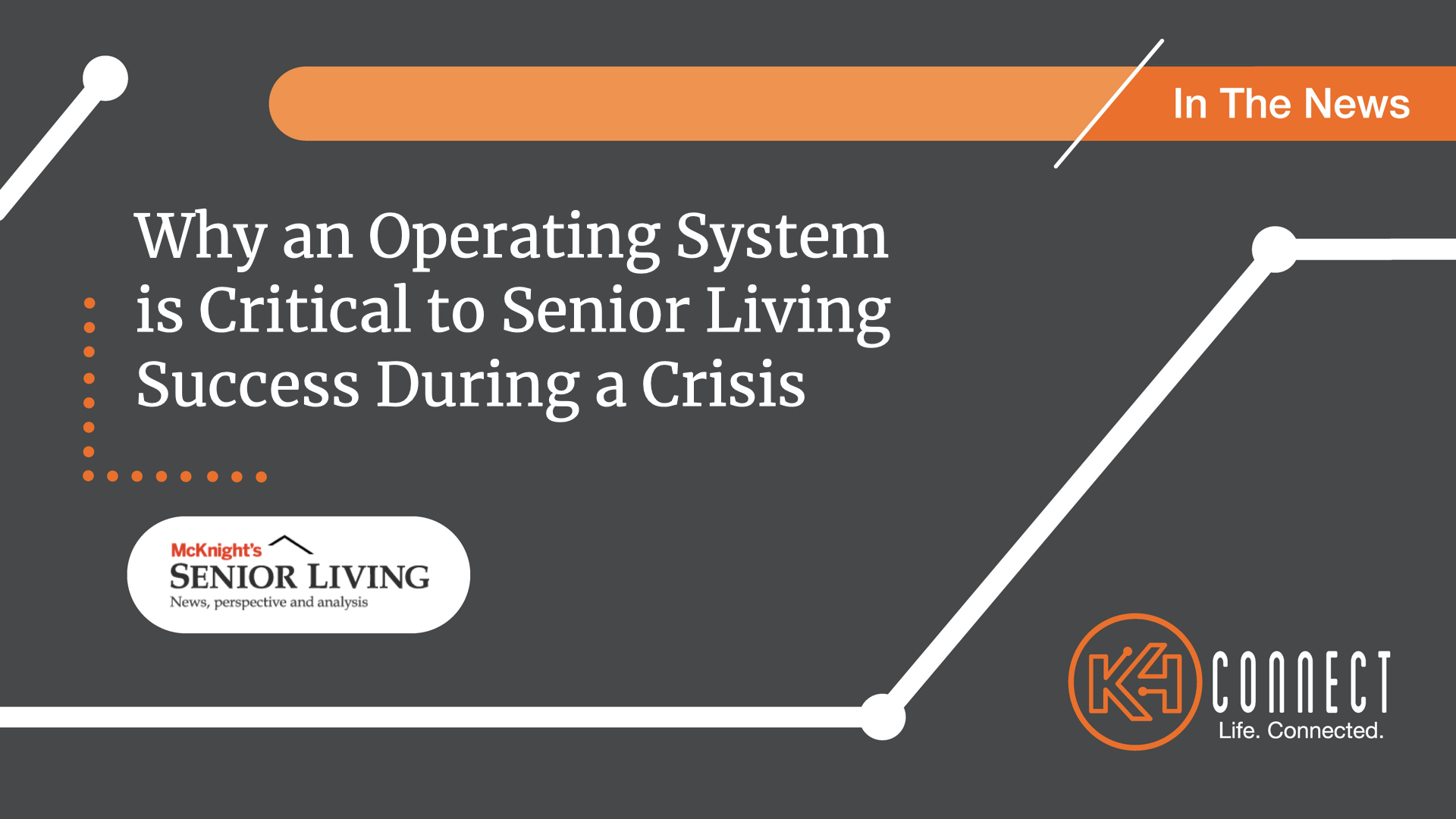One of the most important lessons from 2020, especially for senior living communities, was the tremendous value of technology in times of crisis. Our K4Community, operating system, approach plays an absolutely critical role, surfacing all of the technology a senior living community needs in one one easy to use place.
May 6, 2021
By: Cindy Phillips, K4Advisors Managing Partner
We’ve passed the one-year anniversary of COVID-19 in the United States, and we continue to reflect on the past year. We learned a lot of lessons, but one of the most important, especially for senior living communities, was the tremendous value of technology in times of crisis.
We saw this happen around the world, and we continue to see it making an impact today. Residents in lockdown relied on technologies to help keep them informed on important community news and information, stay engaged with access to virtual activities and, most importantly, create ways to maintain contact with family and loved ones through digital communications like video chat.
But although COVID accelerated the need for these solutions, technology traditionally has not been developed to serve the older adult user — this brings inherent challenges. For residents, that’s often learning new apps and devices, managing personal accounts and using new technologies designed for younger demographics. For staff members, managing and supporting all of these different systems on top of everything else they are managing day-to-day, not to mention during a crisis, becomes incredibly difficult. Ultimately, the more barriers to adoption and usage, the higher the risks of technology actually providing value to the users (in this case, residents and staff).
This is where the operating system, or OS, approach plays an absolutely critical role, surfacing all of the technology a community needs in one one easy to use place. The OS acts as a centralized management system that propels the technology helping senior living residents live their lives to the fullest.
Among many benefits of an OS, there were three categories we saw increase in importance over the past year, and we expect it to continue well into the future as senior living continues to adopt more and more tech.
Stay informed – scaled communication
We’ve learned during the past year just how important it is for senior living community staff and operators to ensure residents stay informed of important news and events, from emergency protocols to daily menus. But delivering this information at scale — and often to different groups — is incredibly difficult without a digital component. Communication during a crisis is all about speed, alignment and coverage — printed materials slipped under doors or posted to common areas is not going to cut it. This process is time consuming for staff and also leaves a significant gap where residents are lacking information.
Having a system throughout a campus that can provide information about COVID-19 safety procedures, or emergency information or more general community news announcements, is key. For example, digital resident communications solutions such as common area digital signage and in-room community TV channels provide a dependable and efficient method of disseminating information quickly and at scale.
Managing and integrating multiple communications systems, however, often is challenging for staff members. Details can get lost between the different communication channels, or information can quickly become out of date or misaligned — the latest update from the Centers for Disease Control and Prevention about mask policies, the day’s menu items, corporate branding collateral, etc.
An OS makes it possible to not just ensure that residents and staff alike receive the right messages; it also gives staff members the tools to do so efficiently. Staff can manage these tasks simply — and even remotely — in one singular interface that speaks to all of these communications channels, saving time while ensuring accuracy.
Stay engaged – Diverse, virtual programming
It’s vitally important for older adults to stay engaged with activities with the surrounding community and the world at large — something that became almost impossible for much over the past year. As activity rooms and group events shut down, communities were hustling to find ways to consistently reach residents inside their homes to keep them engaged. An OS gives senior living communities access to all sorts of apps that do this — from mindfulness to entertainment — and seamlessly deliver it through connected tools such as a mobile application or an in-room TV channel. Staff members no longer are needing to find time to create socially distanced or at-home programming on top of the crisis management they’re tasked with; instead, they are bringing engagement content directly to residents with expansive libraries of activities and experiences.
Other apps allow older adults to easily access virtual activity calendars and get updates about a community’s clubs and organizations. Some communities might offer their own social media system to help residents develop connections. It’s even possible to record video content to share with others. We’ve also seen some of our communities engage in socially distanced hallway singalongs using Amazon Alexa, which shows how technology can empower creative solutions.
But, no matter how it’s accomplished, staying engaged is important for the well-being of residents, and it’s an easy to use system can make all these things come together easily and efficiently.
Stay connected – Dependable family connections
At the top of the list for any older adults’, or any age for that matter, quality-of-life is to stay connected to loved ones. Every grandparent wants to see and hear their grandchildren or children. Over the years, friends may have moved around the country but still want to remain close. It’s also crucially important to have a communication system in place to contact family members in case of an emergency.
But it’s tricky for many older adults to stay on top of the latest communication trends, such as Zoom or FaceTime, that make keeping these connections easy. An OS can create easy-to-manage ways for residents to have a video chat with family and friends, integrating a variety of tools and apps that allow residents to communicate however they prefer. This can even include hands-free communication via voice-activated devices to dial a phone number or to have an email read out loud.
An OS propels the technologies that help older adults keep in touch with those closest to their hearts — as well as with all forms of communications that keep them informed and engaged. At the same time, it gives staff the support they need to seamlessly deliver and manage these new solutions at scale. Having an OS in place allows communities to accomplish what they need to today while laying a technology foundation that allows them to easily expand as their needs evolve — something that proved invaluable during the crisis of the past year. Whether a global pandemic or other crisis scenario that brings similar challenges, the OS approach ensures communities have the ability to quickly, and at scale, launch the tools and resources they need.

